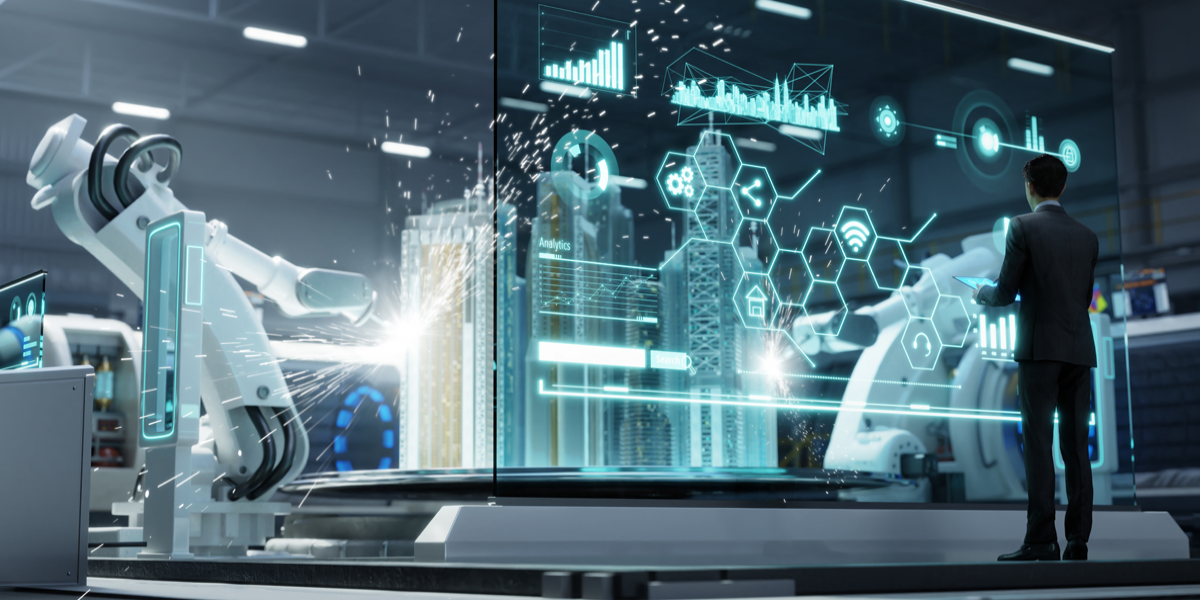Smart Factories: Giving Form to Digital Transformation in the Manufacturing Industry
A Closer Look at Digital Twins, Virtual Factory Models that Expand the Potential of Their Real Counterpart
In scientific and technical research, industrial product development, and other applications, computer simulations support work of all kinds. From semiconductor chips to electronic circuits to machine parts, engines, and other sophisticated mechanical systems – even chemicals and materials – digitally modeling industrial products makes it possible to accurately reproduce real-world electrical, mechanical, physical, and chemical phenomena on a computer. This approach also enables us to develop effective, efficient design or production processes without actually having to spend time, effort, and money on repeated prototyping and testing.
Digital twins: virtual factory models
Technologies for IoT, digital modeling, and advanced analysis meet in a form of simulation known as digital twinning that is becoming more and more valuable (Fig. 1). As a digital model on a computer, a digital twin fully reproduces factory functionality and conditions to support problem-solving or planning for higher productivity or quality. It is a fundamental technology essential in building cyber-physical systems (CPS), the core information system for smart factories.

Simulation to date has created digital models from design data and other data to predict product characteristics or behavior under the various analytical conditions applied. Digital twin analysis differs because data representing real-world properties or behavior detected by sensors or the like is applied to a digital model (based on design data) in real time. As actual objects age and deteriorate, and as their environment of use changes, their properties and behavior changes. Digital twins enable analysis that accounts for these realistic changes.
Conventional simulation is used mainly to narrow down optimal conditions to meet the requirements, given many material and structural options at the time of design. By contrast, digital twins let us see how things that already exist may be a little in the future. They help us find operating conditions for more effective use of products, adopt optimal and efficient maintenance practices, and more.
Benefits of peering slightly ahead, into the future of a factory
In what situations are digital twins likely to be useful for smart factories?
One application is creating production schedules for lines with variable-mix variable-lot production . Changeovers required in these production lines tend to disrupt or temporarily stop the flow of production, which reduces productivity. For mixed production lines making multiple products at once, it is extremely difficult to find a production schedule that accounts for these setup changes while maintaining maximum productivity of the factory as a whole.
To create production schedules, manufacturers have traditionally relied on the experience of seasoned supervisors. By introducing digital twin analysis, manufacturers can rapidly conduct trial-and-error analysis of various production line operating conditions on a computer. This enables efficient changeovers in a production schedule that offers maximum productivity.
As long as the behavior of line equipment is always reflected in the digital twin, manufacturers can also speed up the simulated passage of time on the computer to see what may happen in the future. The benefit of this, for example, lies in predicting and taking preventive action against several problems: short stoppages (which occur after an accumulation of out-of-sync operation between processes on the line), timing for replacement of consumable machine tool parts, and timing of failure due to fatigue.
Technologies to implement and take advantage of digital twins
Effective use of digital twinning hinges on creating high-precision digital twins that accurately capture properties and behavior close to those of real objects.
This calls for modeling technology that applies knowledge of physics and chemistry, as well as sensor technology to collect data that accurately reflects conditions of objects at the factory (Fig. 2). Sensors used in these applications must also be environmentally resistant and highly reliable to collect highly accurate data even where they are subject to high temperatures, significant vibration, or electromagnetic noise.

Moreover, analyzing the digital twin to find optimal production and line operating conditions requires advanced information processing technology. Big-data analysis, AI, and perhaps one day, quantum computers may be combined for this purpose. It may be hard to imagine now, but we stand at the verge of an era where even smaller factories will be able to use AI and quantum computers through cloud services for digital twin analysis and factory improvement.
Digital twin applications are not limited to smart factories. Digital twinning is being used to capture business activities across companies, distribution across supply chains, and even social activities across cities, as users seek optimal operation.
Related articles
- The Inseparable Relationship Between Digital Transformation and Decarbonization and Technologies Essential for a Sustainable Manufacturing Industry
- From automation to autonomy and collaboration, manufacturing robots are advancing to become smarter
- Automated Guided Vehicles (AGV) Have Evolved into Smart Autonomous Mobile Robots (AMR) and Are Improving the Efficiency of Operations in Factories

